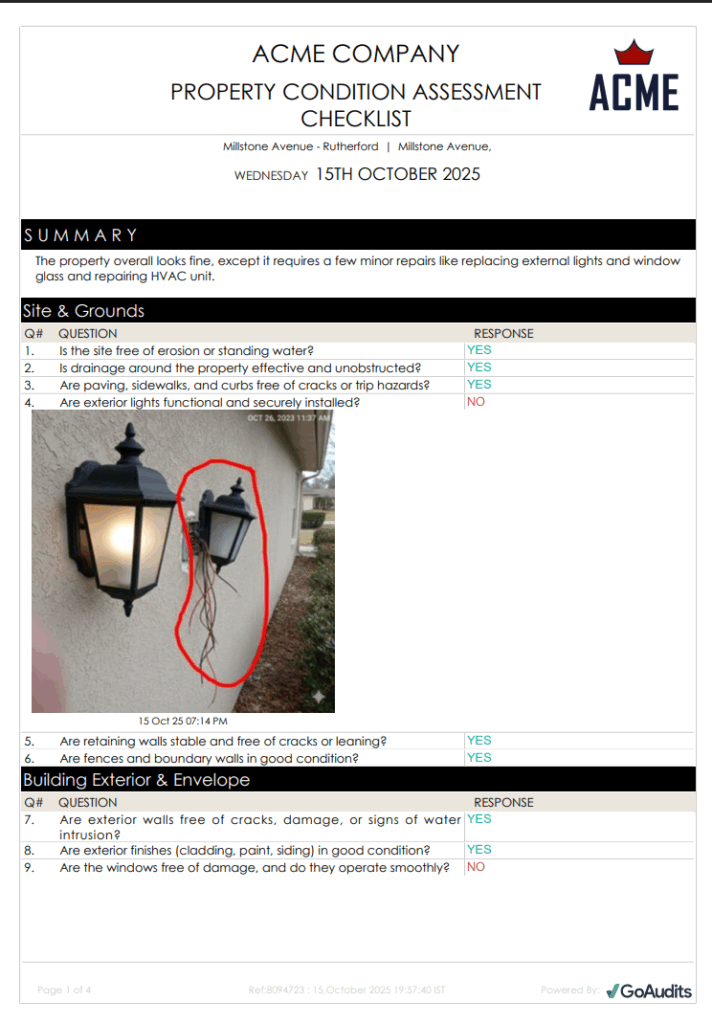Key Takeaways
- A property condition survey report is a non-negotiable tool for due diligence, capital planning, and mitigating long-term risk across all property types.
- Manual report compilation is time-consuming, error-prone, and leads to costly delays in management and investment decisions.
- A property inspection app like GoAudits streamlines data collection and instantly generates professional, comprehensive reports, turning hours of office work into minutes.
A robust Property Condition Report is a critical risk management and financial planning tool. From minimizing tenant disputes to securing multi-million dollar investments, the quality of your condition assessment matters.
Explore how to draft comprehensive, high-quality Property Condition Reports, complete with a free, downloadable building condition report template generated using the GoAudits inspection app.
- What is a Condition Survey Report?
- What are the Different Types of Property Assessment Reports?
- How to Draft a Property Condition Survey Report?
- Free Property Condition Report Template (Sample PDF)
- Draft Comprehensive Condition Reports in Minutes
- Streamline Property and Building Condition Surveys With GoAudits
- FAQs
What is a Condition Survey Report?
A condition survey report is a formal, detailed document resulting from a physical inspection of a property or facility. It provides an objective evaluation of the building’s current condition, noting visible defects, necessary repairs, potential maintenance issues, and the overall state of major building systems.
This report is typically prepared by a qualified property inspector, building surveyor, facility manager, or environmental engineer, who is also known as a Property Condition Assessor. The preparer must possess the necessary technical expertise to assess structures, systems (like HVAC, electrical, and plumbing), and building envelopes.
A common condition report example is the RICS Condition Report, now known as a RICS Home Survey Level 1, in the UK. We’ll discuss this and other major report types in the following sections.
What’s the Purpose of a Property Condition Report (PCR)?
A well-drafted real estate condition report serves several vital purposes across the real estate lifecycle:
- Due Diligence and Risk Mitigation: For buyers and lenders (especially in commercial real estate), the report provides essential information for a go/no-go investment decision. It highlights liabilities and potential costs, allowing the buyer to renegotiate the purchase price or request seller credits.
- Maintenance Planning: It pinpoints existing defects and deferred maintenance issues that require immediate attention, allowing property managers to schedule and prioritize work orders efficiently.
- Legal & Insurance Compliance: In cases of sale, transfer, or insurance claims, the report provides an indisputable record of the property’s condition at a specific point in time.
- Capital Planning: A robust report often includes an estimate of the immediate and near-term capital expenditures (CapEx) needed over a defined period (e.g., 5 to 10 years). This is crucial for budget forecasting and long-term asset management.
What are the Different Types of Property Assessment Reports?
The term “condition report” is broad and changes slightly depending on the property type, audience, and goal of the assessment.
Home & Residential Building Condition Assessment Reports
These reports are primarily focused on an individual homebuyer. The primary goal is to inform the buyer about the condition of the home before closing, covering everything from the roof to the foundation and major home systems. The RICS Level 1 Report falls under this category.
What Exactly are RICS Surveys?
In the UK, the Royal Institution of Chartered Surveyors (RICS) standardizes residential property surveys into three clear levels of reporting:
– Level 1 (Condition Report/Home Survey Level 1): This is the most basic inspection, providing a simple “traffic light” rating of defects. It’s best suited for newer, standard properties that are in good condition.
– Level 2 (Home Buyer Report): A more detailed report than Level 1, which includes advice on repairs and potential maintenance issues, making it suitable for standard properties in reasonable condition.
– Level 3 (Building Survey): This is the most comprehensive survey. It is essential for older, large, unique, or run-down properties, as it includes a thorough analysis of construction and defects.
Commercial Property Condition Assessment Reports (PCAs)
The acronym PCA is common in the USA. A Property Condition Assessment Report is specifically designed for commercial real estate transactions. This assessment is a vital component of the due diligence process for lenders and investors.
A typical PCA, often performed according to the ASTM E2018 Standard, includes:
- An inspection of the physical condition of the property.
- A review of pertinent documents (e.g., building permits, maintenance records).
- Interviews with property managers and owners.
- The preparation of a “Replacement Reserve” schedule, which is an estimate of costs for major system replacements over the projected holding period.
Facility Condition Assessment Reports
A Facility Condition Assessment Report is a strategic tool for facility and asset managers, often performed on a portfolio of properties. Unlike a transaction-driven PCA, facility assessment focuses on long-term asset management and planning.
It usually includes an FCI (Facility Condition Index), which is the ratio of deferred maintenance and capital repair needs to the current replacement value of the facility. This helps prioritize resource allocation across different buildings.
Facility Inspection Checklists: Explore our library of free checklists related to safety, cleaning, maintenance, and other facility audits.
Rental & Tenancy Real Estate Condition Reports
These reports document the state of a property immediately before a tenant moves in and after they move out. They are essential legal documents for landlords and tenants, serving as proof of the property’s condition to manage security deposits and disputes over wear and tear.
Case Study: How Woodside Homes leverages the GoAudits property inspection app to streamline reporting and corrective actions.
How to Draft a Property Condition Survey Report?
Drafting an effective building condition assessment report is the crucial post-inspection process where raw data is transformed into an actionable, professional document. This compilation process must be systematic to ensure clarity and accuracy.
- Review and Data Consolidation: Organize field notes, time-stamp photographs, and verify the location and context of each observation. Use a property inspection software like GoAudits to automatically generate a prefilled report with photos and notes for the specific checklist item.
- Defect Analysis and Condition Rating Assignment: Analyze the collected data to determine the severity and urgency of each noted defect. Assign a clear condition rating (e.g., using a 1, 2, 3, or traffic light system) to every major system and component.
- Financial Modeling (Costing and Capital Reserves): For investment-grade reports (PCAs), calculate the immediate costs of deferred maintenance and repairs. Crucially, develop the Capital Reserve Schedule, the multi-year forecast detailing when and how much capital expenditure will be required for major component replacements.
- Writing the Narrative and Executive Summary: Write detailed descriptions for each major section and component, ensuring the language is objective and easily understood. Most importantly, draft a clear and concise Executive Summary that isolates the highest-priority defects, liabilities, and required CapEx, ensuring the client gets the critical information immediately.
- Final Compilation, Branding, and Delivery: Assemble all sections into a single, polished document. Apply professional branding (logos, color schemes), ensure proper formatting for printing or digital viewing, and deliver the final Property Condition Report PDF to the client.
What Should a Property or Building Condition Report Include?
Regardless of the type, a comprehensive property condition disclosure report must be easy to read, scannable, and actionable. Here are the essential sections:
- Executive Summary: It provides a brief summary of the property, the scope of the inspection, and a clear list of the most significant and urgent defects or liabilities.
- Property Description: General information, including the property’s name, address, size, use, year built, and construction type.
- Site and Grounds: Inspection of parking lots, sidewalks, landscaping, drainage, fencing, and retaining walls.
- Structural Systems: Assessment of the foundation, framing, load-bearing walls, and roof structure.
- Building Envelope: Detailed inspection of the roof covering (age, wear, leak signs), exterior walls (siding, masonry, paint), windows, and doors.
- Mechanical and Electrical Systems: Evaluation of the HVAC, plumbing, and electrical systems.
- Vertical Transportation: Inspection of elevators, escalators, and lifts, where applicable.
- Life Safety Systems: Review of fire suppression systems, alarms, and emergency lighting.
- Deferred Maintenance and Repair List: A table that itemizes defects, the required corrective action, the assigned condition rating, and estimated repair costs.
- Capital Reserve Schedule (for PCAs/FCAs): A multi-year projection of when major systems will need to be replaced and the associated replacement costs.
- Conclusion and Recommendations: A final summary of the findings and actionable advice for the client.
- Attachments: Photos, interview notes, and professional credentials.
Property Inspection Checklists: Browse our library of free property condition report forms to find one based on your needs.
Free Property Condition Report Template (Sample PDF)
To help you visualize a professional, polished final product, we’ve created a free sample report. This customizable property condition assessment report example was instantly generated on the GoAudits mobile app, using the property condition assessment checklist:
You can further customize this or any of your reports to include:
- A professional cover page with your company’s logo
- Numbered ratings for instant recognition of risk areas
- Embedded, annotated photos right next to the findings for clarity
- A dedicated section for recommended actions and CapEx items, and more
Inspection Report Samples: Explore types of reports you can generate and modify with GoAudits.
Free Property Condition Survey Checklists
Use our pre-built digital checklists to ensure you never miss a critical detail during your assessment.
- Building & Facility Maintenance Checklists
- Commercial Building Inspection Checklists
- Property Condition Assessment Checklist
- Facility Condition Assessment Template
- Property Damage Report Template
- Home Condition Survey Checklist
- Building Inspection Checklists
Essential Building & Property Inspection Checklists
If your client only needs a targeted evaluation, or if you want to focus your audit on high-risk areas, use these specific digital checklists:
- Building Exterior Maintenance Checklist
- Electrical Panel Maintenance Checklist
- Footing and Foundation Checklist
- Residential Plumbing Checklist
- HVAC Maintenance Checklists
- Chimney Inspection Checklist
- Termite Inspection Checklist
- Roof Inspection Checklists
- Pool Inspection Checklist
- Attic Inspection Checklist
- Checklists for other interior components, such as ceilings, floors, doors, and windows.
Draft Comprehensive Condition Reports in Minutes
For property managers and inspectors, the most time-consuming part of their job isn’t the inspection itself, but the manual reporting. Hours are often wasted back at the office, transcribing handwritten notes, organizing hundreds of photos, and wrestling with inconsistent Word or Excel templates. This manual approach is also prone to error, can lead to inconsistencies, and ultimately to costly delays in decision-making.
Use a property inspection software like GoAudits to bypass these challenges. GoAudits simplifies the entire workflow, allowing you to focus on a thorough assessment while the app handles the complex compilation, delivering a professional report instantly upon completion of the inspection.
Streamline Property and Building Condition Surveys With GoAudits
GoAudits is a property inspection software that enables real estate professionals to inspect and manage maintenance for all properties in their portfolio on a single platform. With features like customizable workflows, automated reporting, and notifications, businesses can keep their clientele updated.
With GoAudits, you can:
- Schedule regular building and maintenance inspections.
- Create checklists based on property type and tailor them to include local building codes.
- Allow your inspectors to generate and share reports with all stakeholders instantly.
- Stay on top of maintenance activities through features like corrective actions and workflow.
- Ensure all properties in your portfolio are in top condition.
With a rating of 4.8 stars on Capterra, GoAudits is trusted by some of the biggest names in the property management industry.
» GoAudits Reviews: Read how companies leverage GoAudits to meet operational and quality standards.
FAQs
A condition survey should be carried out by a qualified professional with proven expertise in building sciences. This is often:
– Residential: A state-licensed Home Inspector.
– Commercial (PCA): Often a professional engineer or architect with specialized experience in commercial buildings.
– Internal: Qualified in-house facility managers or maintenance engineers.
The duration depends heavily on the size and complexity of the property.
– A simple residential home condition report (like a Level 1) might take 1 to 2 hours.
– A comprehensive commercial PCA for a large property can take a team of inspectors 1 to 3 full days on-site, with report compilation taking an additional week.
A Level 1 condition report, as defined by RICS in the UK, is the most basic and least expensive type of property survey. It is suitable for conventional, newer properties in good condition. It focuses on a simple “traffic light” rating of the property’s condition, highlighting visible defects and risks, but it does not include advice on repairs or maintenance planning.




